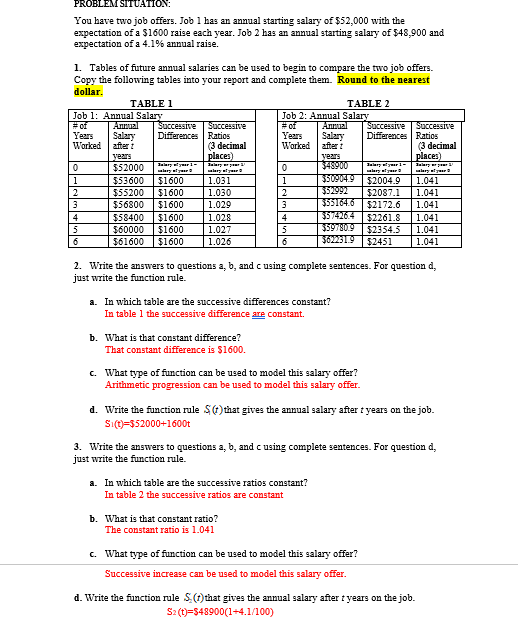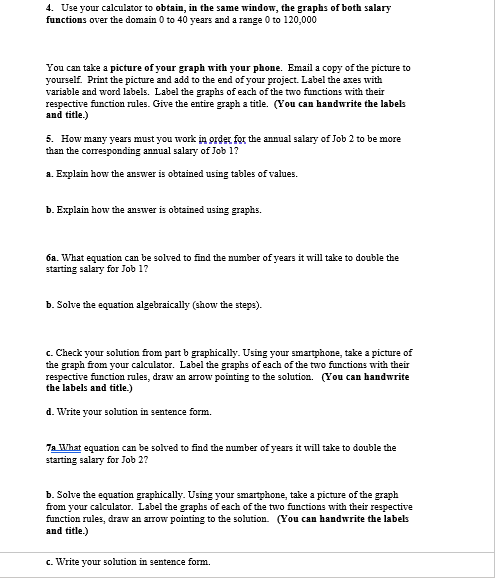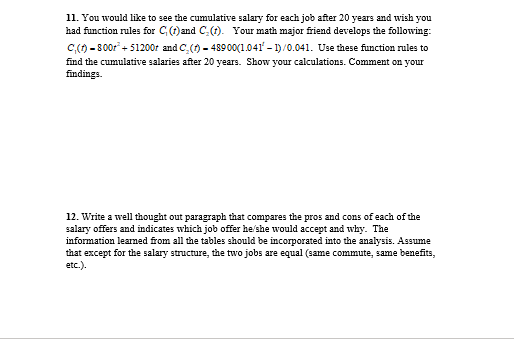Please take a picture on the TI-84 calculator of the graphs thank you.
PROBLEM SITUATION: You have two job offers. Job I has an annual starting salary of $52,000 with the expectation of a $1600 raise each year. Job 2 has an annual starting salary of $48,900 and expectation of a 4.1% annual raige 1. Tables of future annual salaries can be used to begin to compare the two job offers. Copy the following tables into your report and complete them. Round to the nearest dollar. TABLE 1 TABLE 2 Job 1: Annual Salary Job 2: Annual Salary # of Successive # of Successive Successive Years alar Differences Ratios Years Salary Differences Ration Worked after (3 decimal Worked after : (3 decimal Year! places Years place: 0 $52000 Jalary sigmar 1- 0 $48900 Jalury sigur 1- 1 $53 600 $1600 1.031 502049 $2004.9 1.041 2 $55200 $1600 1.030 2 $52997 $2087.1 1.041 $56800 $1600 1.029 3 $56164 6 $2172.6 1.041 4 $58400 $1600 1.028 574264 $2261.8 1.041 $60000 $1600 1.02 $597809 $2354.5 1.041 6 $61600 $1600 1.026 $2451 1.041 2. Write the answers to questions a, b, and cusing complete sentences. For question d, just write the function rule. a. In which table are the successive differences constant? In table 1 the successive difference are constant b. What is that constant difference? That constant difference is $1600. c. What type of function can be used to model this salary offer? Arithmetic progression can be used to model this salary offer. d. Write the function rule S () that gives the annual salary after t years on the job. Si(t)=$52000+1600t 3. Write the answers to questions a, b, and c using complete sentences. For question d, just write the function rule. a. In which table are the successive ratios constant? In table 2 the successive ratios are constant b. What is that constant ratio? The constant ratio is 1.041 c. What type of function can be used to model this salary offer? Successive increase can be used to model this salary offer. d. Write the function rule S () that gives the annual salary after t years on the job. 52 (t)=$48900(1+4.1/100)4. Wee your calculator to obtain, in the same window, the graphs of both salary functions over the domain 0 to 40 years and a range 0 to 120,000 You can take a picture of your graph with your phone. Email a copy of the picture to yourself. Print the picture and add to the end of your project. Label the axes with variable and word labels. Label the graphs of each of the two functions with their respective function rules. Give the entire graph a title. (You can handwrite the labels and title.) 5. How many years must you work in order for the annual salary of Job 2 to be more than the corresponding annual salary of Job 1? a. Explain how the answer is obtained using tables of values. b. Explain how the answer is obtained using graphs. Ga. What equation can be solved to find the number of years it will take to double the starting salary for Job 1? b. Solve the equation algebraically (show the step:). c. Check your solution from part b graphically. Using your smartphone, take a picture of the graph from your calculator. Label the graphs of each of the two functions with their respective function rules, draw an arrow pointing to the solution. (You can handwrite the labels and title.) d. Write your solution in sentence form. 7a What equation can be solved to find the number of years it will take to double the starting salary for Job 2? b. Solve the equation graphically. Using your smartphone, take a picture of the graph from your calculator. Label the graphs of each of the two functions with their respective function rules, draw an arrow pointing to the solution. (You can handwrite the labels and title.) c. Write your solution in sentence form.3. In comparing the earning power of the job offers, one might be interested in the cumulative earnings, that is, the sum total earnings for all the years worked in the chosen job. TABLE 3 on the next page gives cumulative earnings for both job offers for the given number of years worked. For example, when : = 8, the table gives C, (8) = 460,800. That means, after working & years in Job 1, the total earnings is $460,800. Note that the last column gives a comparison of the cumulative earnings of both jobs for the same number of years worked by calculating the difference. Complete the table below. TABLE 3 Comparison of Cumulative Earnings 1= # of Year: G (1) = Cumulative C (1) = Cumulative Difference in Cumulative Worked Exmings after t years Exminge after t years Eaming:: on Job 1 on Job 2 C()-C() 1 $52,000 $48.900 $3.100 2 $105,600 $99.805 3 4 5 6 $460,800 $452,184 $525,600 $519,624 10 $592,000 $589,828 11 $660,000 $662,911 -$2,911 Da. The ordered pair ( 2, 55, 200 ) occurs in the TABLE 1. Explain the meaning of this ordered pair in the context of the situation. b. The ordered pair ( 2, 5, 795) occurs in the TABLE 3. Explain the meaning of this ordered pair in the context of the situation. c. The ordered pair ( 2, 99, 805 ) occurs in the TABLE 3. Explain the meaning of this ordered pair in the context of the situation. 10a. Write a short paragraph describing the pattern of entries that appear in the 'Difference in Cumulative Earnings' column as r the number of years worked, increases from 1 to 11. (Use the words increase and decrease.) b. How many years must you work in order for the cumulative salary of Job 2 to be higher than the cumulative salary for Job 1? Explain how TABLE 3 gives this information11. You would like to see the cumulative salary for each job after 20 years and wish you had function rules for C (r)and C(r). Your math major friend develops the following: C (1) - 800r + 51200r and C(1) - 48900(1041 - 1)/0.041. Use these function rules to find the cumulative salaries after 20 years. Show your calculations. Comment on your findings. 12. Write a well thought out paragraph that compares the pros and cone of each of the salary offers and indicates which job offer he'she would accept and why. The information learned from all the tables should be incorporated into the analysis. Accume that except for the salary structure, the two jobs are equal (same commute, same benefits, etc.)










